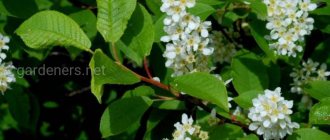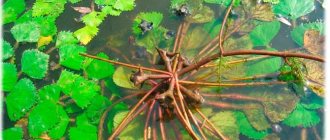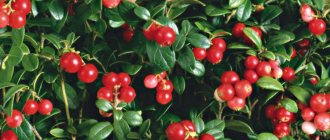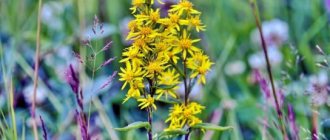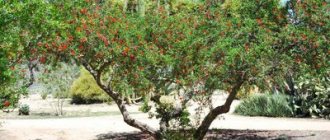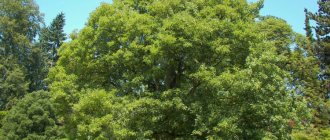Figs are very popular all over the world, another name for the plant and its fruits is fig, fig, wineberry, Carian ficus, fig tree and common fig tree. This is one of the most ancient plants cultivated by man. The homeland of figs is the mountainous regions of ancient Caria, a province of Asia Minor. The trees are grown as a valuable fruit plant in Central Asia, the Carpathians, Crimea and the Caucasus. Figs are widespread in the Transcaucasus, Mediterranean countries, the Iranian Plateau and Krasnodar. In the 13th century BC. Figs were a very important plant in the agriculture of the kingdom of Pylos. It came to America at the end of the 14th century.
What does a fig look like?
The plant belongs to the genus Ficus, the Mulberry family, and grows in the form of low trees or shrubs. The leaves are large, divided into 3-5-7 lobes each. In the axils of the leaves, shoots develop that bear inflorescences of 2 types: figs and caprifigs. They develop on different trees, each axis grows into a formation with a hole at the top and a cavity inside, where inconspicuous and small dioecious flowers are located, the pollination of which is distinguished by a peculiarity - this process occurs with the help of blastophagous wasps that transfer pollen from male flowers to female ones. Moreover, without fig flowers, wasps cannot reproduce.
The fruits are juicy, taste sweet and aromatic, the pulp with numerous seeds, from raspberry to dark cherry color. The shape of the fruit is pear-shaped, the peel is thin, with small hairs, it can be green, greenish-yellow, purple and black-violet. At the top of the fruit there is an eye, which is covered with scales. The harvest is harvested from mid-August to the end of September.
General information
Initially, the ancient Arabians began to grow figs. Subsequently, their experience was adopted by the peoples of Egypt, Phenicia and Syria, and then by the ancient Greeks.
Fig photo of tree and fruit
Sweet fig fruits were highly valued for their nutritional value; they could be stored dried for a long time, and during periods of poor grain harvest they came out on top in demand.
For a long time, Ficus Carian was the only known genus in European countries.
It was brought to America at the end of the 16th century; it became known in Russia only in the 18th century. under the modified name "fig".
Currently, the fig tree is grown in countries with warm tropical and subtropical climates:
- in Central Asia;
- in the Caucasus;
- in Crimea.
Carian ficus is highly valued as a fruit bearer due to its high nutritional value and abundance of yield. How do figs grow? Plants live a very long time by human standards - the oldest specimens are more than 150 years old.
The fig tree is a light-loving tree; sufficient lighting is the main condition for fruiting. Figs also require a warm, humid climate to grow well.
What does a fig look like? Under natural conditions, fig trees reach a height of 10 m. Their trunks are covered with light gray smooth bark. The hard, large leaves have several separate lobes.
The fruit is an infructescence consisting of many drupes. The fruits are pear-shaped and may differ in color depending on the variety:
- green;
- reddish;
- yellow;
- yellow-green;
- purple;
- black and purple.
Unripe fruits are poisonous, so only fully ripe fruits should be collected.
Fig varieties
There are more than 1000 varieties of figs, which differ in the shape and taste of the fruit, yield, and resistance to drought and frost. The most popular varieties among gardeners are the following:
- Brunswick (Buzoy Burnu, Chapla), a self-fertile variety, produces a few large fruits in the first harvest, weighing up to 200 g. In the second harvest, there are more fruits, but they are smaller. The peel is light green, the flesh is crimson. The fruits are very tasty, the tree tolerates frosts down to -28 degrees;
- Kadota, a self-pollinating variety, the fruits are pear-shaped, slightly rounded, weigh up to 60 g. The peel is light green, the flesh is sweet and juicy, of a bright pink hue. The fruits tolerate transportation well and tend to wither directly on the tree. Great for drying, making jam and preserves;
- Dalmatian (Turkish white), one of the best early ripening table varieties. It produces a harvest 2 times a year, the fruits of the first harvest weigh up to 180 g. The rich yield of the variety occurs in the first 3 years. Tolerates frosts down to -15 degrees. The fruits are pear-shaped with a grey-green skin. The pulp is reddish, juicy and sweet with sourness;
- Crimean black, a self-fertile variety, produces crops 2 times a year. During care, it is important to pay attention to pruning and shaping the crown of the tree. The peel of the fruit is black with a purple tint; the flesh tastes sweet and sour;
- White Adriatic (Sochi), the variety is self-fertile, but if pollinated, it gives a large harvest. The fruits are oval with a flat top, weigh up to 60 g. The pulp is very sweet, pink in color, the peel is yellow-green.
Care
Following the care recommendations increases the stability of figs and its productivity.
Fig care
Watering mode
Seedlings are watered very abundantly after planting. In the future, the frequency of watering is reduced to several times a month. However, it is impossible to completely stop watering during the formation of inflorescences, because the plant is moisture-loving. To save water, it is recommended to mulch.
Watering stops only during the period of fruit ripening. The plant is watered for the last time after all the fruits have been collected. This increases its frost resistance.
Top dressing
The rules for feeding the plant are as follows:
- Nitrogen fertilizers are applied in the first third of the growing season.
- In the middle of summer, phosphates need to be added.
- Potassium fertilizers are applied in late summer and early autumn.
- Every month, microelements necessary for tree growth are added.
- Foliar feeding is carried out 2 times a month.
- Organic fertilizers include soil and humic acids.
Why don't figs bear fruit?
Readers are interested in why figs drop their fruits. The plant may not bear fruit due to pests. Most common:
- moth (causes rotting of fruits, causing flowers to fall off and crumble);
- leaf roller (infects the plant so that the leaves may turn yellow, the fruits rot, the stem dries out, and the figs stop flowering);
- psyllid slows down the development of the stem;
- The pine beetle infects the bark, causing the plant to die.
pine beetle
Feeding during fruiting
During the fruiting period, potassium fertilizers are applied. It is important to feed the plant before the end of the growing season, i.e. when the second stage of fruit ripens.
Preparing for winter
In autumn, when all the leaves have fallen, the bushes bend to the ground. Then they are tied and sprinkled with earth or dry leaves. You can cover the plant with layers of leaves or spruce branches, and additionally protect it with roofing material on top.
Note! You need to bend the branches very carefully so as not to break them.
When frost sets in, the branches are covered with black spunbond (2 layers). After some time, the plant is additionally covered with a layer of plastic film.
In spring, the shelter is gradually removed. It can be completely removed only when stable spring weather sets in without a return of frost.
Figs are a beautiful heat-loving plant that decorates the garden and bears delicious fruits. It is not difficult to grow, despite its vulnerability to frost.
Benefits of figs
Figs have long been considered a cure for many diseases; they contain a lot of phosphorus, zinc, selenium, potassium, copper, sodium and calcium, coarse fiber, and pectin. Fruits contain a lot of carbohydrates and sugar. There is more iron in fruits than in apples. Figs contain vitamins A, C, B, E and PP.
Plant cholesterol is beneficial to the body and provides protection to blood vessels from the penetration of high-density molecules. Omega fatty acids strengthen and restore the nervous system, while glyceric acid removes impurities and toxins from skin pores. Fig syrup improves and normalizes the functioning of the digestive tract, intestines and stomach, including in children. The fruits cleanse the walls of blood vessels and have a beneficial effect on the functioning of the heart. It is recommended to eat figs for dystrophy and severe weight loss, the optimal amount per day is 5 fruits.
Eating figs improves the condition of bones, skin and hair, slows down the aging of the body, increases the level of hemoglobin in the blood, strengthens vision and immunity, improves intestinal function, complexion, prevents and stops the development of cancer, thanks to the presence of antioxidants, helps with nausea. 100 g of fresh figs contain 54 kcal. Dried fruits contain 257 kcal. This product is very nutritious and is especially useful for problems with the heart and blood vessels, thrombosis, swelling of the vocal cords, anemia and radiation.
The pulp of fresh fruits is used to treat wounds, burns and boils; a piece of fig and a decoction of it helps with toothache and gum inflammation. Regular consumption of fruits and a decoction of leaves is a good prevention of intestinal helminthic infestations.
Contraindications
Despite their rich chemical composition, sweet fruits can harm the body. The fruit is not recommended for diseases of the gastrointestinal tract and pancreatic pathology, since excess fiber can provoke the development of inflammatory processes.
Also at risk are people suffering from:
- diabetes mellitus;
- gout;
- impaired carbohydrate tolerance;
- obesity.
The average daily consumption of dried figs for an adult is 50 g, for a child – 30 g. An overdose will lead to upset stool and other adverse reactions of the body.
Variety - black prince
Benefits of dried figs
Figs have been used in folk medicine since ancient times. Healers effectively treated many health problems with fruits and decoctions:
- bronchitis
- heat
- cold
- fever
- cough and sore throat
- coarsening of the pleura
- chest pain
- anemia
- arrhythmia
- atherosclerosis
- stones in the kidneys and bladder
- rheumatism
- skin diseases
- constipation
- gastritis
- tachycardia
- vascular and heart diseases
Story
Over its thousand-year history, the plant more than once became part of the legends of the Ancient World:
- In Rome it was believed that the founders of the city, the brothers Romus and Remulus, were nursed by a she-wolf under the bushes of a fig tree, fig tree or wineberry (acceptable names for figs).
- In Greece - that Cleopatra died from the bite of a snake that slid out of a basket with the queen’s favorite fruits.
Also in Ancient Greece there was a special cult of figs. He was revered and considered a sacred symbol of love, fertility and fertility. They filled baskets with them and gave them to newlyweds with wishes for a rich life and many heirs. Smuggling valuable fruits was punishable by charges of treason and execution. And the end of the period of their collection was accompanied by public festivities.
At the behest of the commander Alexander the Great, a tonic potion was prepared from figs, herbs and nuts, replenishing the strength of soldiers after a battle.
Fig decoction recipe
Fig decoction
Ingredients:
- 2 tbsp. l. dried fruits;
- 1 stack milk.
Preparation:
Boil figs in milk until the fruits soften. Take 100 g 2-3 times a day for gastritis. The medicine is suitable for gargling, used externally as a poultice for boils, abscesses, acute inflammation of the periosteum and connective tissue.
Cough remedy
Ingredients:
- 1.5 liters of pasteurized milk 3.2% fat;
- 1 dried or fresh fig.
Preparation:
- Heat the milk and put the washed figs in it.
- Bring the liquid to a boil, keep it on low heat for 30 minutes with the lid tightly closed. The volume should decrease by 1/3.
- Cover the pan and leave until it cools completely so that the figs steam. 3-4 hours is enough.
The medicine is stored in the refrigerator, in a jar with a nylon lid, helps with whooping cough and coughing attacks during colds, and increases the body's resistance. The course of treatment is 10-15 days.
Fig tree propagation
The fig tree can be propagated by seeds, cuttings, root shoots and offsets. The simplest methods are cuttings and propagation by cuttings.
Seed propagation
It is difficult to propagate figs by seeds, so this method is not suitable for novice gardeners. The seeds are pre-germinated at home. For this:
- At the beginning of spring, planting material is planted in nutritious, moist soil to a depth of 3 cm.
- Before emergence, the container is covered with polyethylene to create a favorable microclimate.
- The strengthened sprouts are transplanted into separate containers.
- Caring for seedlings involves regular watering.
- The seedling is planted in the prepared place at the age of 2 years.
By layering
You should choose a strong, healthy branch that is located close to the ground and place it in a pre-dug trench. Sprinkle the shoot with soil so that the top remains above the surface. Compact the soil and water it abundantly. After new leaves appear on the shoot, it must be dug up and transplanted to the chosen location.
Reproduction by layering
By cuttings
Figs can be propagated from green and woody cuttings. Green cuttings are cut immediately before rooting. A well-ripened lower branch with 3-4 buds is suitable for this. The planting material is cut 10-15 cm long. The upper cut is made straight, the lower cut is oblique, and several longitudinal furrows are cut above it. For rapid root formation, it is recommended to place the cuttings in a Heteroauxin solution for 12 hours.
Next, the lower cut should be sprinkled with ash and the cutting should be buried at an angle into the nutrient soil. Water the planting material and cover with a jar. After the leaves appear, the cover must be removed and the container moved to a warm place. If agricultural practices are followed, rooting will occur within 30 days.
Root shoots
A simple way to propagate low-growing varieties. You need to carefully dig up the root, separate it from the mother bush and plant it in a sunny place.
Fig Recipes
Figs are canned and used to make preserves, jam and compote. In preparations, the fruits go well with nuts and lemon. It is added to baked goods as a filling, combined with cinnamon, cottage cheese, cheese, raspberries, oranges, and peaches. Confectionery products are prepared from figs: marmalade, candies, cookies, gingerbreads, marshmallows, and cakes. In the preparation of desserts, the fruits are combined with honey and nuts, and they are made into puddings, pastes and sweet sauces. In America, a cake with figs called “Lady Baltimore” is very popular; it is served for holidays and wedding celebrations.
Figs go well with meat; they are used when stuffing duck, turkey, lamb, pork and beef. The fruits themselves are also stuffed; the filling is made from meat, cheese, ham, bacon and fruit. Fig sauce goes well with various meat dishes. The fruits give fish an interesting taste; figs go especially well with salmon, sea bass and chum salmon.
Figs are added to porridges made from semolina, rice, buckwheat and oatmeal; vegetable and fruit salads, cocktails, wine, jelly, tinctures, vodka and medicinal juices are prepared with them. The fruit goes well with various types of cheese: goat, Parmesan, Dorblu, mozzarella, Roquefort, Gorgonzola.
Preparing for winter
After the end of the growing season at average temperatures of about 2 degrees Celsius, you can begin to cover the bushes. To do this you need:
- Remove autumn structures: arcs, non-woven material and polycarbonate.
- Bend the branches to the ground.
- Lay boards or sheets of plywood on top of the pit.
- Lay a durable film over the flooring.
- A layer of earth of about 10 cm is poured over the entire structure. It will prevent frost from penetrating the tree.
In particularly frosty regions, you can add an additional layer of insulation.
The presence of air in the shelter will ensure normal aeration of the plant.
In particularly frosty regions, you can add an additional layer of insulation. The following can act as natural insulation:
- straw;
- corn tops;
- spruce branches
The following can be used as cargo placed on polyethylene:
- boards;
- cardboard;
- roofing felt
If the covering material is too dense, small holes are made in it to allow air to enter.
Fig desserts
Fig and cherry dessert
Ingredients:
- 1 tbsp. l. cherry jam;
- 150 g ripe figs;
- 100 ml cream 33%.
Preparation:
- Whip the cream into a medium-density foam.
- Reserve 3 teaspoons and place the rest on a plate.
- Cut the fruit crosswise, but do not cut all the way through.
- Place fig flowers over whipped cream.
- Place a spoonful of cream in the center of each fruit.
- Place 1 jam cherry on top;
- Pour a tablespoon of jam around the perimeter of the plate.
Baked figs with mascarpone, nuts and red wine
Ingredients:
- a glass of dry red wine;
- 0.5 stack. Sahara;
- 0.3 tbsp. l. balsamic vinegar;
- 450 g dried figs;
- 120 g mascarpone;
- 100 g walnuts.
Preparation:
- Cut off the stems of the fruits.
- Combine sugar with vinegar and wine, place over medium heat.
- Cook until the sugar is completely dissolved, stirring occasionally.
- Place figs in syrup and cook for 5 minutes.
- Fry the chopped nuts in a dry frying pan.
- Pour everything into a baking dish, sprinkle with nuts and place in the oven at 190 degrees.
- Bake for 30 minutes on the middle shelf of the oven. The figs should become soft and absorb 2/3 of the liquid.
- Remove the finished dish and leave for 15 minutes at room temperature.
- Serve the figs warm with mascarpone and the syrup in which they were baked.
Interesting Facts
The fig tree is a close relative of the indoor ficus and distant relatives of the mulberry. Knowing their relationship, scientists spent many years crossing figs with frost-resistant mulberries. In America, the then famous scientist Luther Burbank tried to implement this idea. However, the Crimean naturalist Ya.I. was able to turn the idea into reality. Bomyk. In the harsh winter of 1950, when frosts reached -20°C, ordinary figs died out, only the fig-mulberry hybrid Bomyka survived.
The gallery below presents photos of a fig tree, which clearly shows all the characteristic features of this amazing and not fully studied plant.
How to choose figs
Figs spoil very quickly, so choosing fresh ones when purchasing is sometimes quite difficult. Pay attention to external factors:
- the smell of the fruit should be pleasant; if it is sour and fermented, it cannot be eaten;
- the surface of the fruit should be elastic and intact, but give in when pressed lightly;
- the fruit should not be hard, this means that it was taken from the tree too early and it will no longer be tasty.
Dried fruits suitable for human consumption must meet the following requirements:
- dark matte or amber beautiful shade of the peel;
- a white coating on the surface is normal, this is excess glucose. These figs are very sweet;
- there should be no dark spots on the peel that indicate spoilage;
- good dried fruits are slightly soft. Hard figs are too dry;
- the fruits should be almost equal in size and slightly flattened;
- the taste should be sweet. The sour fruits were stored incorrectly or were of poor quality when fresh.
Problems with fruiting
Figs in the country
Obtaining fig tree fruits at home is not always effective. You should always remember that a plant, being not in its own climate, experiences certain difficulties with vegetation and metabolism.
Below are the most common problems in keeping figs at home, the solution of which will help make the crop bloom and bear fruit.
| Cause | Possible Solution |
| Lack of lighting | In the summer, move it to an open sunny place in the garden or take it out to the balcony. In winter, place it on the brightest windowsill in the apartment. |
| Too much space for the root system | Transplant the plant into a smaller container. If the plant is planted in the garden, limit the space occupied by the root system using polyethylene stretched over the frame. |
| Damage to the crown in winter from low temperatures | Provide the plant with additional watering and fertilizing; On average, crown restoration takes about 3 months |
| Pest infestation | After the cause is destroyed, the plant should be treated with Epin or similar phytohormones. |
| Excessively dense crown | Trim off excess branches. Sometimes they are simply shortened. Re-form the crown, leaving two skeletal branches on the tree. Pinch the ends of the shoots. Reduce the amount of fertilizers containing nitrogen. |
| Lack of nutrition (leaves wilt or turn yellow) | Compliance with correct agricultural technology - timely watering and fertilizing. |
VIDEO: How to grow figs at home Home greenhouse
Growing figs
Since the homeland of figs is the subtropics, growing plants in our latitudes should be taken seriously. The most effective method is trench, the place should be well lit. A self-pollinating fig variety, for example Magacharsky or Date, is suitable for planting.
Trees planted using the trench method hardly suffer from frost even in the coldest winter. Planting consists of several stages:
- choose the sunniest place on the site. It is desirable that tall buildings or tall trees be located on three sides, except the south, not block the light of the plant and protect it from the winds;
- dig a trench 1.5 m deep and 1 m wide, the depth can be narrowed to 60-80 cm. Dig the trench in the direction from west to east so that the figs receive the maximum amount of sun during growth. On the south side the trench should be flat;
- if the soil is heavy and loamy, add drainage to the bottom;
- prepare the substrate: mix surface soil with meadow or leaf humus, you can use compost or rotted manure;
- pour everything into the hole so that its depth becomes 100-120 cm less;
- pour earthen mounds in increments of 2 meters, place one seedling on top of each, spread the roots evenly along the slopes of the mounds;
- cover the seedlings with soil to a level just above the root collar;
- Cover the slope to the pit on the south side with boards or thick black film. This will prevent the growth of weeds that may block the bottom of the plant from the sun;
- on the north side, install a wall made of polymer, slate or white painted boards. This way the soil will not fall into the hole with the seedling.
Figs need regular watering; the soil should not be allowed to dry out completely. Crown pruning will increase yield. The tree trunk space needs to be periodically loosened and mulched. Fertilizers are introduced every month; in the spring, phosphorus-potassium and nitrogen fertilizers are useful; during the growing season, humus, superphosphate and potassium salt are needed. In June, fertilizing with nitrogen-containing substances is carried out again.
When the first frost occurs, the plant must be covered. Fig bushes are placed in furrows 40 cm deep and pinned. The top is covered with spruce branches or leaves, and a 20 cm layer of earth is poured. If the conditions are more severe, roofing material or boards are placed on top. If you grow figs in a pot indoors, for the first 5 years you need to transplant them into a larger container.
A tree grown in open ground under indoor conditions can bear fruit for up to 30 years, twice a year. The plant pleases not only with its sweet and healthy fruits, but also with its beautiful appearance.
Planting a seedling after purchase
Thuja - tree, what it looks like, varieties and varieties
A seedling can be grown in two main ways: at an angle of 45 degrees and with the formation of a horizontal cordon. In the first case, bending down the branches in front of the shelter is easier. In the second case, the seedling is planted vertically, its top is cut off. Side shoots bend to the ground.
Planting figs
The shoots are arranged like sleeves directed in different directions. They form buds from which branches grow. The fig harvest ripens on them.
What is needed for planting
For planting, a hole is dug about one and a half meters long, about a meter wide and up to 80 cm deep. Great depth is not needed, because the roots of this plant branch horizontally.
The top layer of soil must be folded separately, it is then poured into the hole. One and a half buckets of humus (it can be replaced with compost), 200 grams, is placed at its bottom. superphosphate and the same amount of potassium fertilizer. Then a small layer of fertile soil is poured.
A mound is formed in the hole on which the roots of the seedling are distributed. They are covered with earth, compacted and watered abundantly.
The plant is planted in open soil around the beginning of May, when the threat of night frosts has finally passed.
Optimal place
First you need to choose the warmest place in the garden that is protected from cold winds. A trench is dug if several plants need to be planted at once.
What does it taste like
Figs are neither a fruit nor a berry, since their pulp contains dozens of small seeds, and the fruits grow on trees. The plant is a ficus inflorescence, has a round, slightly oblong shape and a dense skin.
The fruits of the fig tree have a sweet, but not cloying taste. Due to the abundant accumulation of small seeds, the pulp crunches on the teeth. The rich aroma is reminiscent of burnt sugar and honey.
Dalmatian variety


